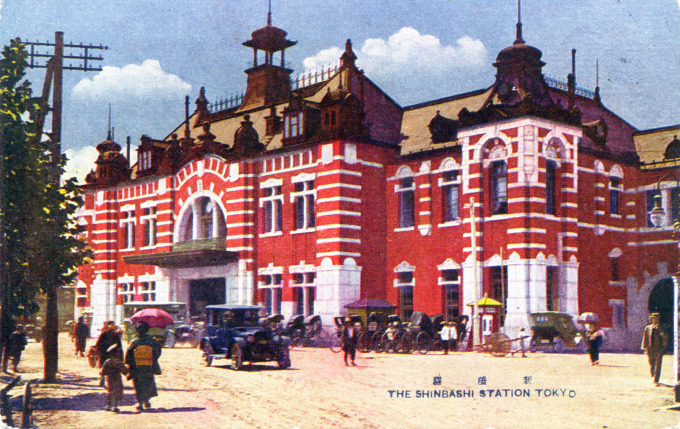
Shimbashi-Kasumori (also known as Karasumori) Station, c. 1920. Even after completion of Tokyo Central Station in 1914, Shimbashi-Kasumori represented the gateway to Tokyo. Sadly, the station would be completely destroyed in the 1923 Great Kanto Earthquake.
See also:
Shimbashi Station (Shiodome), 1872-1909
“Around the city of Tokyo there are the five terminus stations the Shimbashi, the Manseibashi, the Uyeno, the Ryogoku, and the Asakusa; but as the great central station is now in course of construction and will be completed in the next year (1914), the lines from these five stations will be concentrated into the new station.
“Among these five stations at present, the Shimbashi, which is the starting-point for the Tokaido line, is always crowded by passengers, and specially those who are going to travel to Osaka, Kobe, or Shimonoseki of the Sanyo line, take the express train in night. It is about seven in the evening when you make appearance in the station to see its general aspect.
“By one side of the stone steps leading to the front entrance there stand three automatic telephone boxes, each of which is occupied, one by a girl and the other two by gentlemen. Close by one of the telephone boxes a money-changer box is found, and an old woman in the box busy on her business of exchange.
“Ascending the stone steps, you pass the entrance and fall into the whirlpool of people. Pushing through the throngs, you approach the first- and second-class waiting-room, where you find ladies and gentlemen in travelling costume, some leaning on the sofa and reading papers, some talking with friends standing by the large table at the centre, magazines and papers being furnished on the table by the station master.
“Porters of red caps are carrying bags and trunks for the train. In the lady’s waiting- room, on the opposite side, you can see some six or seven young and old ladies of the peer’s rank, attended by their chambermaids. Then you come to the large waiting-room for the third-class passengers; men and women who constantly come in and out of the room are about to shock with you, and their chatters and idle talks with loud voices are raising a confused noise within the room. Most of [the] people assembled in this room are rustics; some dangle a cotton bag from their neck, and some carry baggages on the shoulder.
“Near the door of the room there is standing a policeman, to whom an old man shows his bald head, by taking off the old ruffled soft hat, and, after bowing down, politely enquires where to buy his ticket. There are two large booking offices fronting each other at the centre of the station ; in one of them there are opened the windows for the first- and second-class and platform tickets, and in the other those for the third-class only.
“… Coming round into the spacious part of the station which leads to the wickets, newsboys are crying for the evening press, and at one corner of the place you find a nicely-decorated shop of miscellaneous articles at the shop passengers buy cigars, matches, magazines, handkerchiefs, and the like. On the wall, near the shop, large square looking-glasses, with advertisement pictures on their broad frames, serve for dandies to touch on the hair or the tie, or on arranging dresses.
“The eastern side of the part is made the way out of the station, and along the wide frontage here rikisha, carriages, and motor-cars are prepared in rows and waiting for guests. At one side of the frontage you find a box of rikisha tickets, and, if any one buys a ticket at the box after appointing his destination, he can take a rikisha to any quarter of the city without troubles to fix the fare himself directly with the rikisha man.”
– “The Nightside of Japan”, by T. Fujimoto, 1914
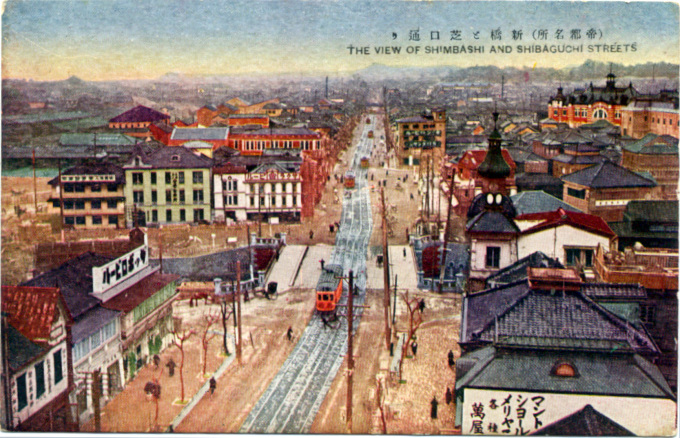
An elevated view of Shimbashi Bridge and Shibaguchi Streets, c. 1910, gateway to the Ginza, looking southwest toward the distant Atago Hill. Shimbashi-Kasumori terminal is at upper-right; the original Shimbashi-Shiodome terminal site, in use from 1872-1909, is at far left.
By 1909, the Japanese national government had assumed control of many private railways throughout the country, and most rail lines with service to-and-from the capital. (A few years before, the Tokyo city government bought controlling rights over the city’s three privately-owned streetcar lines.)
Plans to complete the Akabane/Yamanote loop began after the mergers; design work was also begun on a new central rail terminal to be located in the Marunouchi district. Track near Shimbashi/Shiodome was rerouted north through Yurakucho, and the original station at Shiodome, completed in 1872, was turned into a freight office.
“A new, more grand-looking gateway to the city and the Ginza, constructed in a post-Victorian style of red brick and quarried stone, was completed 16 December 1909 as Karasumori [crow forest] station to the west of the old Shiodome terminal. With the extension of the Tōkaidō Main Line along its modern-day route to the new terminus at Tokyo Station in 1914, and after the demolition pf Shiodome Station, and Karasumori Station was renamed Shimbashi Station.
As solid and as sturdy as it looked, this new Shimbashi station was completely destroyed in the 1923 Kanto earthquake. By that time, though, its importance as a terminal had diminished following the opening of Tokyo Central Station in 1914, the extension of the Tokaido Main Line there, and the eventual consolidation of all rail lines into Tokyo at that terminal. When a new Shimbashi station was rebuilt after the earthquake, it looked much as it does today – just another ordinary commuter stop on the Yamamote-sen.
- The Shimbashi Station (Kasumori), c. 1920. Elevated view, with Atago Hill in the distance.
- Shimbashi Station, Tokyo, c. 1920.
“Any traveler coming out of Shimbashi station in Tokyo for the first time, and gazing on the depressing scene with its wilderness of advertisement of beer, soap and patent medicine, may well fling up his hands in horror. Who shall blame him if he think that if this is what the Capital of the Empire is going to show him, he might just well have stayed quietly in London and taken a walk down Euston Road.
“… Here all is bustle and noise; everywhere a foreign style buildings are springing up, and to use an expressive Japanese phrase, Tokyo is fast becoming ‘high collar’.”
– The Overland Monthly: At Nara and the Tomb of Jimmu Tenno, February 1910
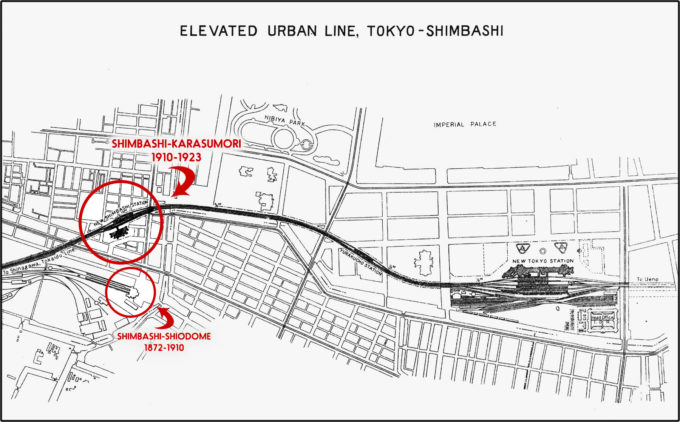
Shimbashi-Shiodome and Shimbashi-Kasumori stations locations, c. 1915. Yurakucho Station (center) would be completed in 1909; Tokyo Central Station (right) opened in 1914.
- A more modest Shimbashi Station was built after the 1923 earthquake, seen here (lower left), c. 1930, looking north toward Tokyo Station with Ginza-dori to the right.
- “Gateway to Ginza.” The same Shimbashi view as seen left, c. 1970.


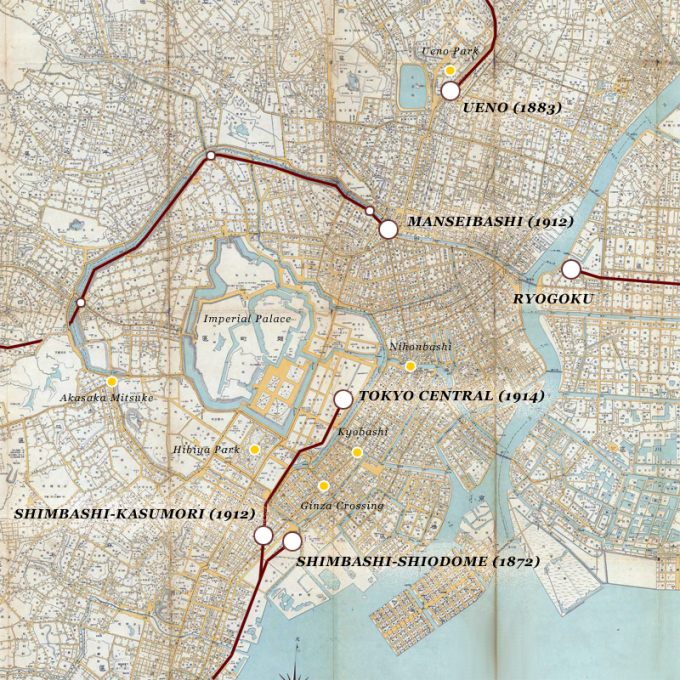
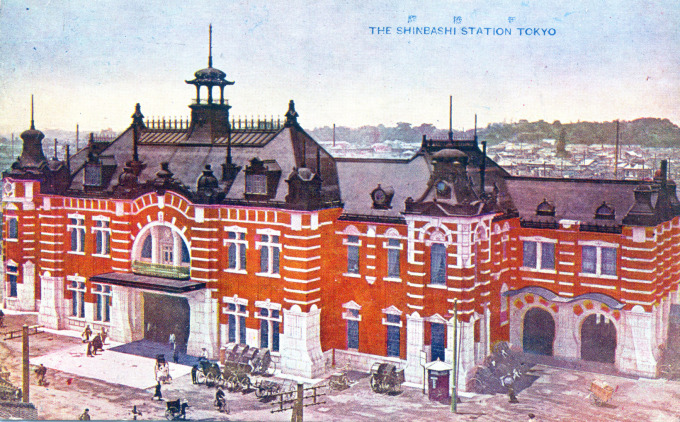
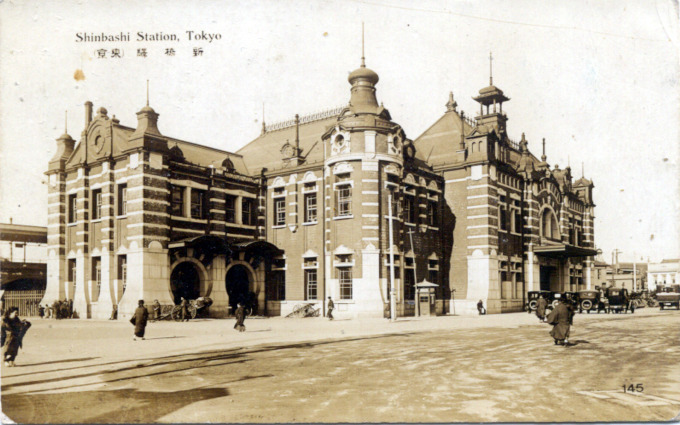
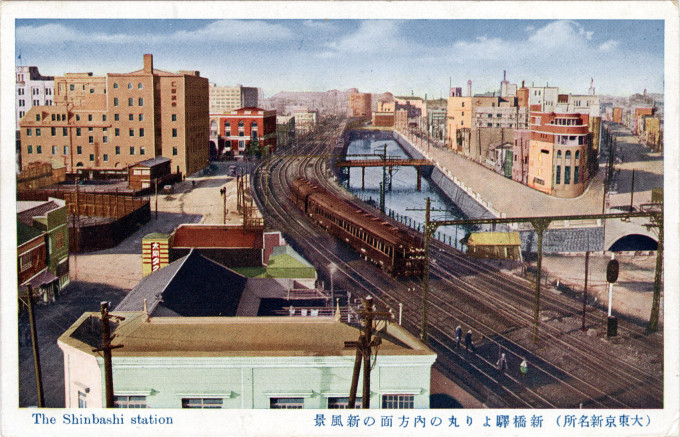
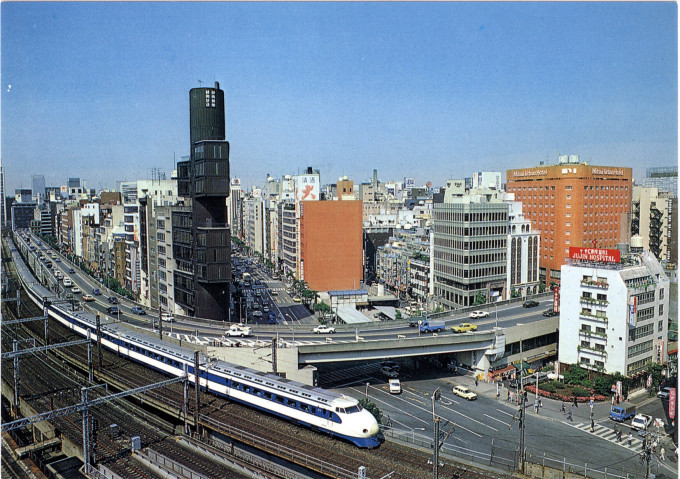
Pingback: Manseibashi Station (1912-1936). | Old Tokyo
Pingback: Ueno Station, c. 1930-1950. | Old Tokyo
Pingback: Shimbashi Station (Shiodome), 1872-1910. | Old Tokyo
Pingback: Tokyo Station, 1914-1940. | Old Tokyo
Pingback: Yurakucho (Tokyo) Station opening, 1910. | Old Tokyo
Pingback: Shimbashi Station (Shiodome), 1872-1909. | Old Tokyo
Pingback: Shimbashi Superguide | Ten Minute Tokyo